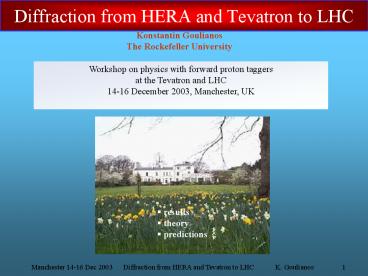Diffraction from HERA and Tevatron to LHC PowerPoint PPT Presentation
Title: Diffraction from HERA and Tevatron to LHC
1
Diffraction from HERA and Tevatron to LHC
Konstantin Goulianos The Rockefeller University
Workshop on physics with forward proton
taggers at the Tevatron and LHC 14-16 December
2003, Manchester, UK
- results
- theory
- predictions
2
Topics
- Soft diffraction
- Elastic and total cross sections
- M2-scaling
- Soft diffraction cross sections
- Multigap diffraction
- Diffractive DIS at HERA
- Derive F2D3
- Explain flat ratio of F2D3 / F2
- Explain rise of e ( or aIP) with Q2
- Hard diffraction at the Tevatron
- Explain ratio of Fjj(SD) / Fjj(ND) magnitude
and shape! - Double-gap hard diffraction
- Diffraction at the LHC
- Soft and hard single and multigap diffraction
- Determine
- triple-pomeron coupling
- pomeron intercept
- diffractive cross section
- using soft parton densities
Predict from hard plus soft parton densities
3
Diffraction at CDF in Run I
16 papers
- Elastic scattering
- Total cross section
- Diffraction
PRD 50 (1994) 5518
PRD 50 (1994) 5550
SOFT diffraction
Control sample
PRD PRL
PRL PRL 50 (1994) 5535
87 (2001)141802 submitted 91(2003)011802
HARD diffraction
PRL reference
with roman pots
4
Two (most) important results
Soft Diffraction
Hard Diffraction
M2SCALING
POWER LAW
KGJM, PRD 59 (1999) 114017
CDF, PRL 84 (2000) 5043
5
Soft Double Pomeron Exchange
- Roman Pot triggered events
- 0.035 lt x-pbar lt 0.095
- t-pbar lt 1 GeV 2
- x-proton measured using
- Data compared to MC based
- on Pomeron exchange with ?
Pomeron intercept e0.1
- Good agreement over 4 orders of magnitude!
6
Total Cross Section
- st exhibits universal rise with energy
- the falling term at low energies has
- NOTHING to do with this rise!
- POWER LAW behavior
t0 elastic scattering amplitude
Parton model of wee partons grows
exponentially
7
Single Diffraction Variables
- SOFT DIFFRACTION
- HARD DIFFRACTION
xDPL/PL fractional momentum loss
of scattered hadron
Additional variables (x, Q2)
Variables (x, t) or (Dh, t)
8
Soft Single Diffraction Phenomenology
- Factorization (re)normalization
Gap probability Normalize to unity KG, PLB
358 (1995) 379
9
The factors k and e
Experimentally
KGJM, PRD 59 (114017) 1999
Theoretically
lg0.20
lq0.04
lR-0.5
10
Soft Single Diffraction Data
Total cross section KG, PLB 358 (1995) 379
Differential cross section KGJM, PRD 59 (114017)
1999
Regge
REGGE
RENORM
s-independent
- Differential shape agrees with Regge
- Normalization is suppressed by factor
- Renormalize Pomeron flux factor to unity
M2 SCALING
11
Central and Double Gaps
- Double Diffraction Dissociation
- One central gap
- Double Pomeron Exchange
- Two forward gaps
- SDD SingleDouble Diffraction
- Forward central gaps
12
Two-Gap Diffraction (hep-ph/0205141)
5 independent variables
color factor
Gap probability
Sub-energy cross section (for regions with
particles)
Integral
Renormalization removes the s-dependence
SCALING
13
Central and Double-Gap CDF Results
Differential shapes agree with Regge predictions
DD
SDD
DPE
- One-gap cross sections require renormalization
- Two-gap/one-gap ratios are
14
Soft Diffraction Summary
Multigap variables Parton
model amplitude
rapidity gap regions color factor
0.17 particle cluster
regions also
t-across gap centers of
floating gap/clusters
Differential cross section
Sub-energy cross section
Normalized gap probability
form factor for surviving nucleon
color factor one k for each gap
15
F2(x,Q2) c x-l
enter HERA
from the talk of E. Tassi _at_ Small-x and
Diffraction 2003, Fermilab
F2 from Compton analysis (H1)
l(Q2) versus Q2
16
Diffractive DIS _at_ HERA
eg0.20
Power-law region xmax 0.1 xmax 0.1 b lt 0.05x
eq0. 04
eR-0.5
17
F2D3(xIP,x,Q2)/F2(x,Q2)
At fixed xIP F2D3(xIP ,x,Q2) evolves as
F2(x,Q2) independent of the value of x
18
Pomeron Intercept in DDIS
1l
19
Diffractive Dijets _at_Tevatron
Test Regge factorization
Test QCD factorization
suppressed at the Tevatron relative to
extrapolations from HERA parton densities
20
Rjj(x) _at_Tevatron
21
RjjFjjSD/FjjND
eg0.20
Power-law region xmax 0.1 b lt 0.05x
eq0. 04
eR-0.5
22
RENORM prediction of R(x) vs data
CDF data
- Ratio of diffractive to non-diffractive
- structure functions is predicted from PDFs
- and color factors with no free parameters.
- ?Fjj(b,x) correctly predicted
- Test processes sensitive to quarks
- will have more flat R(x) diff W?
R(x)
RENORM prediction
exp-syst-errors
23
HERA vs Tevatron
(re)normalized gap probability
Pomeron flux
24
Another issue
- QCD evolution
Rjj(xBj) vs Q2
No appreciable ET2 dependence observed within
100 lt ET2 lt 1600 GeV2
25
Dijets in Double Pomeron Exchange
Test of factorization
R(SD/ND)
equal?
R(DPE/SD)
(not detected)
The second gap is less suppressed!!!
Factorization breaks down, but see next slide!
26
DSF Tevatron double-gaps vs HERA
The diffractive structure function derived from
double-gap events approximately agrees with
expectations from HERA
27
SUMMARY
- Soft and hard conclusions
Hard
SOFT
Diffraction is an interaction between low-x
partons subject to color constraints
28
Inclusive Diffractive Higgs at the LHC
enter LHC
pp ? p-gap-(HX)-gap-p
sD(LHC) k2 sND (Tevatron) gt
(0.17)2 1 pb 30 fb

